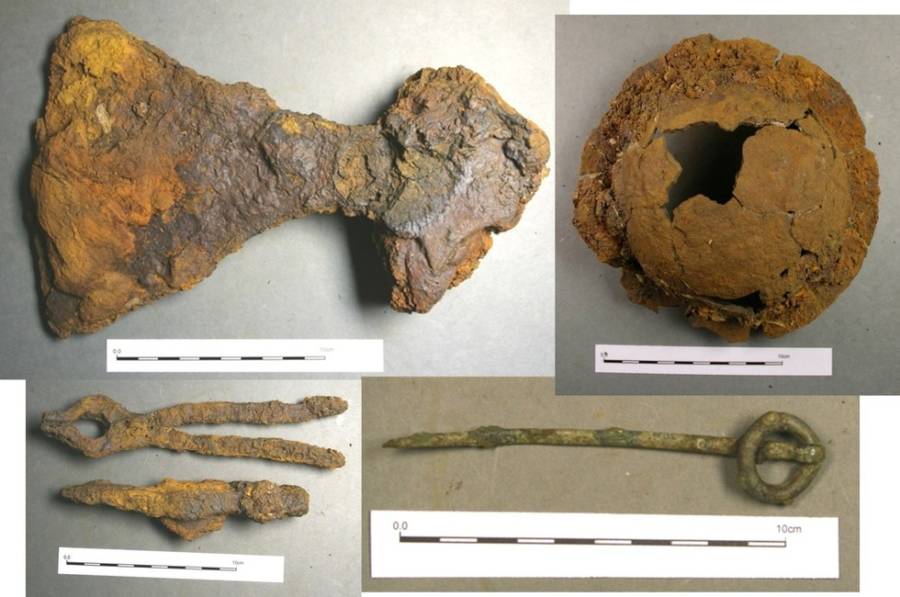Uncovered Viking Funeral Ship In Scotland Contains Treasure Trove Of Ancient Relics
A boat which for 1,000 years served as the grave of a high-status Viking has revealed some of its secrets, according to the first detailed report of the iconic discovery.
The tomb, originally unearthed in 2011 on the Ardnamurchan peninsula in western Scotland, contained a rich assemblage of grave goods. It represents the first undisturbed Viking boat burial found on the British mainland.
Viking boat burials have been documented in Scandinavian countries, but are fairly rare. They involve using the boat as a coffin for the body. Archaeologists estimate the boat used to bury the deceased dates back to the late 9th or early 10th century, at a time when Vikings were still exploring and trading along the British Isles.
An in-depth investigation, published in the journal Antiquity, has revealed much of the Viking funerary rite involved in the burial at this remote part of Scotland. However, some mystery remains. The ship rotted into the soil long ago, like the bones of the interred individual.
Only two teeth (both molars) remain of the human. The absence of a body which researchers can biologically sex might raise the compelling, albeit remote, possibility that it was a female boat grave.
“The burial is probably that of a man — but as we only have the two teeth surviving, it is impossible to be definitive. So it is possible, but not likely, that this was the burial of a woman,” Oliver Harris, co-director of the Ardnamurchan Transitions Project (ATP) at the University of Leicester’s School of Archaeology and Ancient History, told Seeker.

The funerary rite began with cutting a boat-shaped depression into a natural mound of small, rounded beach stones. The boat was then inserted and the body was placed inside, surrounded by a variety of artifacts including a sword, an axe, a drinking horn vessel, a shield boss, a ladle, a sickle, and a ringed pin.
“There is nothing female per se in the grave, though of course there are lots of objects — sickle, the ladle, the knife, the ringed pin — that are not male either,” Harris said.
The grave was filled to the top with stones which may have been taken from a nearby Neolithic burial cairn (a human-made pile of stones).”The final artifacts found in the boat, the spear and shield boss, were higher in the burial, deposited as part of the closure of the monument,” the researchers wrote.
The spearhead was deliberately broken before being deposited, indicating some form of ritual associated with the burial process. The archaeologists also recovered 213 of the boat’s rivets. From the outline of the boat impressed into the soil, they established the boat measured 16 feet in length and would have been a small rowing boat, probably accompanying a larger ship.
Isotopic analysis of the teeth suggests the deceased likely grew up in Scandinavia. It also showed that between the age of 3 and 5 the person’s diet switched for about a year from meat to fish, an unusual food supply at that time.”The switch in the diet probably shows there was some shortage of food for a period of time leading people to eat more fish,” Harris said.
Most importantly, the Viking boat burial reveals the growing relationship between Scotland and the Viking world at that time. It brings together multiple geographic connections, as shown by the grave goods.
A whetstone, used to cut and sharpen tools, was made from a rock that is found in Norway, while the bronze ring pin, likely used to fasten a burial cloak or shroud, appears to come from Ireland.”The burial evokes the mundane and the exotic, past and present, as well as local, national and international identities,” the researchers wrote.
According to Colleen Batey, Senior Lecturer in Archaeology, University of Glasgow, the grave goods within the find are very significant.”A sword with shield boss, spearhead and ax are a complete weapon set — which is not so common. And the ladle is an exceptional and uncommon find,” she told Seeker. She added that there is nothing in the burial boat which would support the identification of the interred individual being a female.
However, Viking female boat burials have been excavated in the past. Batey has just published details about a boat grave from Shetland, in the Scottish Islands, which may well have been for a female, or at least one of the occupants may have been a woman, buried with her oval brooch.
One of the most famous Viking ship burials was excavated in 1945 in the Isle of Man at Balladoole. This boat burial contained a man, as well as a woman who had been sacrificed in order to be added to the grave.
Source: allthatsinteresting





